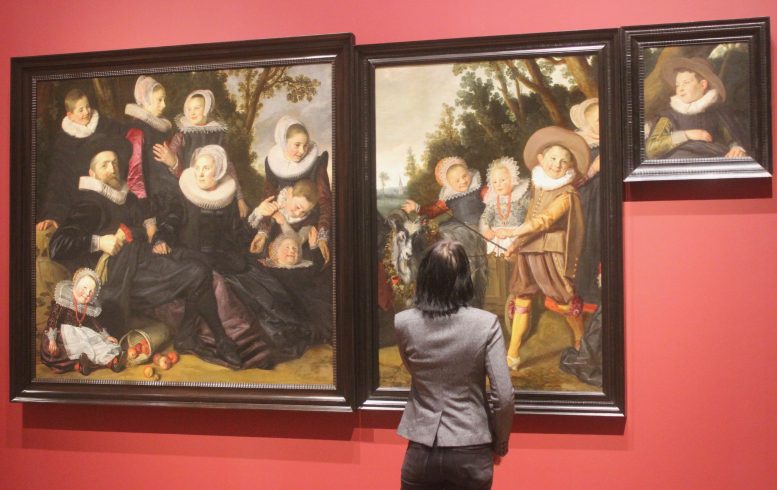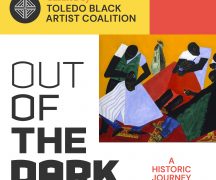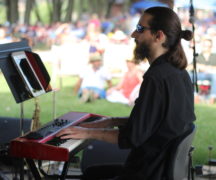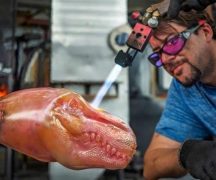By DAVID DUPONT
BG Independent News
The Van Campen Family is having a reunion at the Toledo Museum of Art.
Other 17th Century Dutch families have joined as well as families, biological and social, from across time and the globe.
That includes the museum’s neighbors. Even I’m invited.
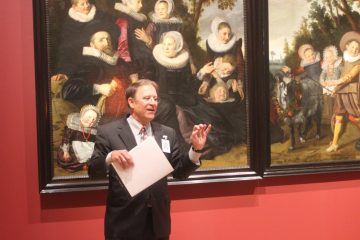
Curator Lawrence Nichols
The international exhibit “Frans Hals Portraits: A Family Reunion” is now at the Toledo Museum of Art.
The centerpiece is a reunification of three parts of the “Van Campen Family Portrait in a Landscape,” a painting from around 1623-25. Over the years this family portrait of the Van Campens and their 14 children has been cut apart. Two parts, the larger portrait and a smaller fragment “Children of the Van Campen Family with a Goat-Cart” first appeared on an auction list in 1810 as separate works.
In 2011 the Toledo Museum acquired the main section, knowing there was another part to the painting owned by the Royal Museums of Fine Arts of Belgium, Brussels.
It has since been discovered that there was indeed a third part, and when set side by side there is likely at least one more fragment.
Lawrence Nichols, the senior curator at the Toledo Museum who oversaw the exhibit, holds out faint hope that remainder may be discovered.
He speculates that the painting probably was damaged, maybe in a fire, and that was the reason it was disassembled. Other theories are posited, including it no longer fit in a smaller house. None will likely ever be proven.
The exhibit also brings together the four other family portraits by Hals, who was known mostly as a portrait painter of individuals. That and other related works form the core of the exhibit. That’s what will travel to Brussels and then Paris after the exhibit closes Jan. 6 in Toledo.
The Toledo Museum, though, is using these works to reflect on the meaning of family as an ever changing concept.
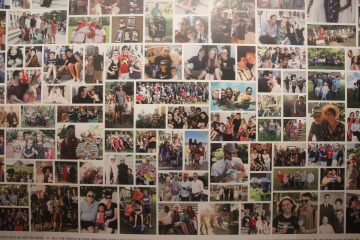
Community photo montage
So the viewer will find in the first of the exhibit’s four galleries a Yoruba mask, “The Mother of Twins,” next to a Albrecht Durer’s 15th century print of Adam and Eve. The definition is stretched to include sub-cultures including portraits of “Ghoullies” taken by contemporary Dutch photographers.
Even before arriving in that gallery, the visitor sees a mural made up of 75 photos of area families, some submitted to the museum and some taken by a museum photographer during the museum’s Block Party in early July. That’s why a photo of my wife, Linda Brown, and me greets me as I enter the exhibit.
Museum Director Brian Kennedy said this montage symbolizes the museum’s efforts “to grow the relationship between the museum and its neighborhood and community.”
Those snapshots show a diversity of ages, ethnicity, and family configurations. They’re also a tribute to a time when selfies and cell phone portraits are the norm. We can capture our family’s image in an instant.
In Frans Hals’ time someone had to hire a painter, like Frans Hals. That’s why the family portraits are displays of wealth. These being the Dutch, those displays are understated.
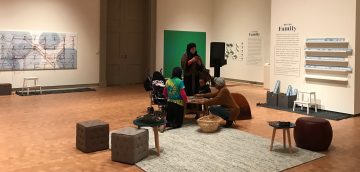
Family gathers in activity space in final gallery of “Frans Hals Portraits: A Family Reunion”
But what makes Hals’ family portraits great is that they aren’t just dour depictions of folks assembled in their finery. The Van Campen family is captured in a moment of spontaneity, snapshot like even. Hals has “an internal drama playing out,” Nichols said, and that’s characteristic of his family portraits.
These capture active, alive people albeit surrounded by signs of their status and symbolism.
In the Van Campen portrait a church steeple is visible in the distance. They were devout Catholics, Nichols noted.
In another, “A Family Group in a Landscape,” a black youngster appears. Nichols said that he is not a stock depiction but is as much an individual as the four others in the frame. Clearly he’s a servant, but still a valued member of the household.
Another, “Portrait of a Dutch Family” captures the endearing interaction between two daughters, the elder doting on the younger.
The other family portrait is “A Marriage Portrait of Isaac Massa and Beatrix Van Der Laen.” Nichols explained it fit with the others “because they will have children.”
That at the time was the expectation of the family, and the Van Campens took that seriously.
The couple, shown in their late 30s — this may have been a portrait to commemorate their 20th wedding anniversary, had 13 children when Hals painted them, and they weren’t done. A 14th came along later, and she was added to a corner of the picture by another painter. Of the 14, half appear in “The Van Campen Family in a Landscape.” Four more are represented in “Children of the Van Campen Family with a Goat-Cart.” And another appears in an even smaller fragment, “Portrait of a Boy of the Van Campen Family.”
This last, on loan from a private collection, was only discovered after the Toledo Museum’s acquisition of its portrait. As the “Goat-Cot” was being cleaned, Nichols said the conservator called him to tell them they had uncovered an eye and expected a face to emerge. This and the edge of a dress connected the third fragment to the whole.
The three pieces leave two daughters unaccounted for and probably depicted in the undiscovered canvas.
The curator Liesbeth De Belie and conservator Catherine van Herck in Brussels brought the entire portrait together in one digital image using parts from the existing canvasses.
Now their reunion is being use as a way to bring contemporary families together and to consider what makes a family. The fourth and final gallery in the show is an open space with room for visitors to sit, and interact.
The museum has dozens of programs scheduled including workshops on how to tell a family story and a showcase of some of the stories.
Kennedy said that combined with the Rebecca Laws’ “Community” show, the museum has much to offer visitors through the fall and into the holidays when the crowd is sure to include many families in all their variety.

